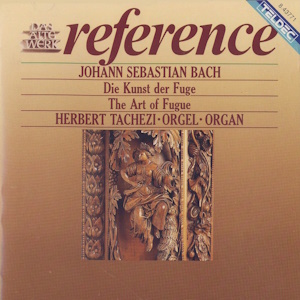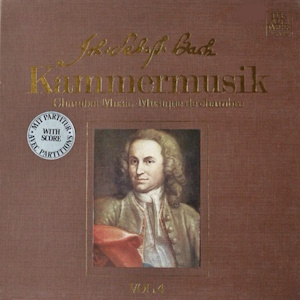 |
| 1 CD -
8.43771 ZS - (c) 1987 |
 |
2 LP -
6.35373 EX - (p) 1977
|
|
DIE KUNST DER FUGUE
|
|
|
|
|
|
|
|
|
|
| Johann
Sebastian BACH (1675-1750) |
Die Kunst der
Fuge, BWV 1080 - Orgelfassung
von Herbert Tachezi
|
|
|
|
|
|
- Contrapunctus I a
4 |
|
3' 07" |
1 |
A1
|
|
- Contrapunctus II a
4 |
|
3' 08" |
2 |
A2
|
|
- Contrapunctus III
a 4 |
|
2' 51" |
3 |
A3
|
|
-
Contrapunctus IV a 4 |
|
5' 12" |
4 |
A4
|
|
- Contrapunctus V a
4 |
|
3' 10" |
5 |
A5
|
|
- Contrapunctus VI a
4 - in Stile francese
|
|
4' 05" |
6 |
B1
|
|
- Contrapunctus VII
a 4 - èer augmentationem et
diminutionem
|
|
3' 52" |
7 |
B2
|
|
-
Contrapunctus VIII a 3 |
|
5' 29" |
8 |
B3 |
|
-
Contrapunctus IX a 4 - alla
Duodecima
|
|
2' 58" |
9 |
B4 |
|
-
Contrapunctus X a 4 - alla Decima
|
|
4' 19" |
10 |
C1 |
|
-
Contrapunctus XI a 4
|
|
7' 03" |
11 |
C2 |
|
-
Canone all'Ottava |
|
2' 50" |
12 |
C3 |
|
-
Canone alla Duodecima - in
contrapuncto alla quinta |
|
2' 15" |
13 |
C4 |
|
- Canone
alla Decima - in
contrapuncto alla terza
|
|
4' 40" |
14 |
D1 |
|
- Canone -
per augmentationem in
contrario motu
|
|
4' 24" |
15 |
D2 |
|
-
Contrapunctus XIII a 3: |
|
|
|
|
|
a) rectus
|
|
2' 50" |
16 |
D3 |
|
a) inversus
|
|
2' 50" |
17 |
D4 |
|
- Contrapunctus XII
a 4: |
|
|
|
|
|
a) rectus |
|
2' 49" |
18 |
D5 |
|
a) inversus
|
|
2' 55" |
19 |
D6 |
|
|
|
|
|
| Herbert
TACHEZI, Orgel von Ahrend
& Brunzema in Bremen-Oberneuland |
|
|
|
|
|
Luogo
e data di registrazione |
|
St.
Johann, Oberneuland, Bremen
(Germany)
|
|
|
Registrazione:
live / studio |
|
studio |
|
|
Producer |
|
-
|
|
|
Prima Edizione
LP |
|
Telefunken
"Kammermusik" Vol. 4 - 6.35373 EX
- (2 LP) - durata 72' 36" - (p)
1977 - Analogico
|
|
|
Edizione
"Reference" CD
|
|
Tedec
- 8.43771 ZS - (1 CD) - LC 3706 -
durata 72' 36" - (c) 1987 - AAD |
|
|
Cover |
|
Detail
aus einem barocken Bilderrahmen
mit König David, Musen, Tugenden
und Lastern. Buchsbaumholz /
Holland gegen 1670, mit
freudlicher Genehmigung des
Museums für Kunst und Gewerbe,
Hamburg.
|
|
|
|
|
The
Organ Version of the
Art of Fugue
It has no
doubt at last been
proved that J. S. Bach
composed his Art of
Fugue neither for an
imaginary orchestra nor
as a theoretical
instructional work. Bach
was too much of a
practical musician not
always to have in mind a
genuine sound when
composing, or to regard
his music merely as an
abstract model for
compositional study and
analysis. Moreover, Bach
was mainly an organist
and harpsichord player.
Despite composition in
the “Italian” score form
which was usual at that
time for playing
keyboard instruments, it
has been apparent for
some years that the long
standing undisputed
thesis concerning
inability of the work to
be played on a keyboard
instrument has ceased to
be tenable. In the
entire work Bach limits
himself to the fingering
range of two hands,
which can only have been
intentional. Similarly
the part augmentations
towards the end of some
fugues point to a
keyboard instrument; at
that time there was as
yet no “divisi” in the
orchestra. Several
research projects have
gone into this problem.
Hans Gal for instance
says: “... for Bach and
his contemporaries it
was taken for granted
that the Art of Fugue
was written for
‘Clavir’”. In his
edition, Tovey
emphasises that “...no
rule of counterpoint was
more conscientiously
observed by Bach than
restriction of the
part-leading to the
fingering range of the
hands”. G. Leonhardt in
his treatise on the Art
of Fugue gave a great
deal of detailed thought
to this aspect. This
work was often played in
concertante style on the
harpsichord. The object
of this essay is to
explain more clearly why
representation on the
organ has also been
constantly considered,
why the organ in
particular should appear
to be especially
suitable for giving
tonal effect to this
compendium of fugues,
and in fact why this
work can be ideally
interpreted on the
organ.
The performability of
many fugues is
technically considerably
alleviated and
simplified by the use of
a pedal keyboard, while
the polyphony is
elucidated; furthermore
the pedal ensures the
complete tonal
independence of the bass
part. When incorporating
the pedal, however, one
is more inclined to
think of the organ than
the pedal harpsichord.
Use of the pedal appears
to be particularly
propitious, even
necessary, with regard
to the mirror fugues. In
view of the fact that,
for instance, the
three-voice mirror
fugues can only be
performed by
occasionally extreme
part shifting or
exchanging, with two
hands in the original
position - which of
course would strongly
inhibit the independence
of the three voices - we
can perhaps understand
why Bach arranged these
fugues for two
harpsichords (each with
an added free voice).
However, the composer
must not necessarily
have conceived this
arrangement as an
integral part of the
overall work. On the
organ the three-voice
mirror fugues project
themselves as genuine
“organ trios”: each hand
on its own manual and
pedal.
As regards the
four-voice mirror
fugues, the theme cues
can also be considerably
emphasised by the
incorporation of pedal
play and the use of two
manuals. In the
Contrapunctus VII (per
augmentationem et
diminutionem) for
instance, the theme
augumentation, which of
course runs through all
four voices (bass,
tenor, alt, soprano),
can be made clearly
audible by shifting to
the pedal and suitable
registration (tongues!).
When performed on the
organ, many of the
part-leading
characteristics of the
work are more easily
heard than on the
harpsichord, and in fact
are often heard for the
first time: pedal
points, stationary
parts, lengthy ties,
syncopation, cantus
firmus-type formations
and theme augmentation.
Altogether, the affinity
in part-leading,
setting, character and
emotion with many fugues
of the great Bach organ
works is conspicuous.
Compare for instance the
counterpoints I, IV, V,
X, XI and XVII, whose
bass voices are
certainly led in “organ
pedal style”, with the
fugues of the “Dorian”
toccata, the F major
toccata, the
passacaglia, the
preludes in C minor, C
major, C major in 9/8
time, of the grand
preludes in B minor, E
minor, E-flat major.
Counterpoint VII is
completely composed in
the form of a chorale
prelude (the theme
augmentation according
with the cantus firmus).
Counterpoint XVI accords
to a large degree with
the fast movements from
the organ trio sonatas.
Notation
of the Art of Fugue is
also attuned to the
organ. Organ works in
score form have existed
since the 16th century,
especially in Italy
(hence the name
“Italian” organ score or
“keyboard partitura”),
starting with works by
Padovano, Maschera,
Frescobaldi; many of the
printed scores are
expressly intended for
the organ. Above all,
this score form remained
restricted to the sector
of contrapuntally strict
forms! It also turned up
in Germany (Scheidt,
Schonsleder) at the
beginning of the 17th
century. Bach himself
had possessed since 1714
a copy of this kind of
Frescobaldi’s “Fiori
musicali”, and in the
representation of some
contrapuntal late works
evidently reverted to
this form. The famous
six-voice ricercare from
the Musical Offering
observes this system of
notation and
nevertheless - already
apparent from
spur-of-themoment
improvised elements and
then noted down - is a
harpsichord piece.
Similar notation applies
to the “Canonic
Variations on ‘Vom
Himmel hoch, da komm ich
her’”. This after all
bears a strong
relationship to the Art
of Fugue which then,
precisely for this
reason, was able to
appear without any
performance practice
directions. Marpurg
praised as a special
advantage of the works
the fact “that
everything in it is
written in the score.”
From the tonal point of
view, rendition on the
organ also has major
advantages over other
keyboard instruments. By
way of suitable and
varying registration one
can also as regards tone
clearly distinguish the
individual fugues from
each other, emphasise
their character in the
rhythm and singularity
(“in style francese”!)
and, if necessary or
desirable, tonally
differentiate between
individual voices,
various emotions or
emotional changes. From
this point of view too,
the instrument by Ahrend
of Bremen-Oberneuland
seems to me to be
eminently suitable for
performing the Art of
Fugue. The North German
prinzipal tone enables
the voice fabric of
complicated
counterpoint, especially
the middle voices, to be
heard three
dimensionally and
strengthens their
independence.
And now a
few points concerning
selection of the fugues
in my version and their
sequence. The sequence
of counterpoint I to XI
was laid down by Bach
himself in the first
edition. The version of
the second double fugue
without first exposition
via the countersubject
can be discarded as a
duplicate; similarly the
arrangement of the
three-voice mirror fugue
for two keyboard
instruments, since of
course the original is
played. From the point
of view of compositional
technique, the canonic
fugues probably best of
all indicate progressive
development in the
sequence all’ottava,
alla duodecima, alla
decima and per
augmentationem in
contrario motu. The
chorale prelude “Vor
deinen Throhn” belongs
to the cycle of the
“Eighteen Chorales” and
was placed by Ph. E.
Bach, probably for pious
reasons, together with
the uncompleted triple
(“Quadruple-”) fugue, at
the conclusion of the
assumedly unfinished
work. It was therefore
not included in my
version, and similarly
the incomplete fugue is
also omitted. As regards
the latter, there are
some differences of
opinion as to whether
this torso is part of
the Art of Fugue or not.
Even Spitta and A.
Schweitzer came out
against this movement
being part of the Art of
Fugue. A more
interesting explanation
is that of G. Leonhardt,
who analysed the Art of
Fugue together with the
musicologist Henk
Dieben. He discovered
that the Art of Fugue -
excluding the
uncompleted piece -
contains the same number
of bars as the
Well-Tempered Clavier I.
In turn, in respect of
the latter, Dieben found
number squares which in
the most varied
connections repeatedly
reveal Bach numbers:
29-J,S,B.-S.D.G. For the
rest, one might mention
that the original theme,
despite the Nottebohm
experiment, fits neither
harmonically
(un-Bach-like friction
in the third bar) nor in
the sole possible
combination (original
theme would end three
bars before the three
other themes) into this
fugue. However, if the
“uncompleted” work were
to take up once more the
original theme after
three expositions, it
would be of inordinate
length (about 300 bars).
By leaving out the torso
section the entire work
itself becomes more
integrated and cyclic.
In my opinion, however,
with the four-voice
mirror fugues in 3/2
time (hinting at the
Holy Trinity by the
tempus perfectum?) which
otherwise produce the
original theme unchanged
(as so often at the end
of a variation sequence,
and after all the Art of
Fugue is also a
variation work), the
conclusion becomes
artistically more
convincing.
Herbert
Tachezi
English
translation by
Frederick A. Bishop
|
|